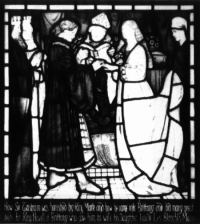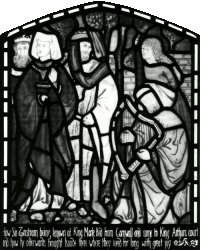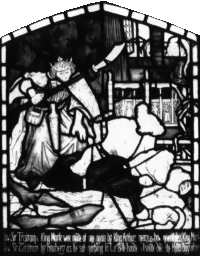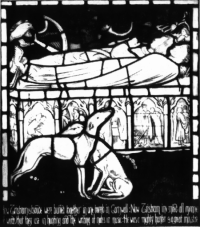The Tristram and Isoude Stained Glass Panels
Paul Lawson
(First published in 1985 in volume 1, pp. 50-55, of the third series of The Bradford Antiquary, the journal of the Bradford Historical and Antiquarian Society.)
Bradford Art Galleries and Museums hold a considerable collection of stained glass ranging in date from sixteenth-century heraldic panels to early twentieth-century figure windows. The collection has been formed over a long period, glass being acquired when the building in which it was installed was either demolished or altered. One of the most significant acquisitions came from Harden Grange, Bingley, in 1917. It consists of a series of panels illustrating the story of Tristram and Isoude made in 1862 by Morris, Marshall, Faulkner & Co., the firm founded largely on the initiative of William Morris, designer, writer and social reformer.
Before considering the panels it may be helpful to say a little about the development of stained glass, an art form which evolved from the twelfth to the fifteenth century. The basis of medieval stained glass was the mosaic principle. To achieve the desired effect windows made from white glass and pot metals, that is glass coloured by the addition of colouring agents in the molten state, were first cut to. shape. These were then arranged to form the basis of the design, details of which were painted on to the glass, using iron oxide with or without the addition of silver nitrate. Next the glass was fired in a kiln to produce the stained effect, brown/black in the case of iron oxide and various shades of yellow in the case of silver nitrate and related substances. The pieces were then fixed together with lead-lines and installed in the window-opening for which they had been made. The mosaic principle particularly suited the translucent nature of stained glass, because the rich pot metals glow when light passes through them, and the stained images are similarly heightened in effect. In well-designed glass the lead-lines complement the basic design and, in certain types of daylight, form abstract patterns. The subjects of windows portrayed the succeeding iconographies of the Middle Ages and followed the stylized decorative traditions of each period. Windows formed two main types, pictorial designs, usually of religious subjects, and abstract patterns of floral and foliate motifs. Most medieval stained glass was installed in ecclesiastical buildings, the windows being made in the workshops of great centres, such as Canterbury, Norwich, Oxford and York.
Following the Reformation the manufacture of stained glass in England declined because of changing religious beliefs and practices. Its patrons were now the aristocracy and gentry, who commissioned heraldic emblems for the windows of their halls and country houses. In addition, from the sixteenth century onwards, the development of enamel colours meant that it was possible to paint on white glass in a variety of colours. Artists were no longer confined to the brown/blacks and yellows of the medieval period. It meant, too, that windows could be made without the use of pot metals or lead cames and, indeed, during the eighteenth century stained glass windows often consisted of one sheet of white glass painted with enamels. Subjects included heraldry and reproductions on glass of Old Master oil paintings. Interesting as these windows often are they lack both the rich, translucent colour of pot metals and the design-enhancing lead cames.
The nineteenth century saw a transformation in the manufacture of stained glass. This was the "revival of medieval practices, including the mosaic principle and the development of the basic techniques of the traditional craft, the whole being part of a larger movement known as the Gothic Revival. The preoccupation with medieval architecture, art and decoration, which originated in the mid-eighteenth century, showed itself mainly in the application of Gothic detail to what were basically Classical buildings. By the second quarter of the nineteenth century, under the influence of A.W.N. Pugin (1812-52), from mere application of principles and techniques the movement was infused with the whole spirit of medieval architecture, and the various decorative arts were caught up in this new aspect of the revival. The medieval 'numinous' of colour and light in the interiors of neo-Gothic buildings, both ecclesiastical and secular, emphasises how much the reforms owed to the designers of mosaic glass.
The new interest in medieval glass began with Thomas Willement (1786-1871). Willement was an antiquarian who carried out lI1uch detailed research to produce, first, heraldic glass and then figure panels in medieval style. His main aim was to revive the old techniques and forms, and he was soon followed by others, such as John Hardman (who worked with Pugin), William Wailes and George Hedgeland, all of whom shared his ambition. In 1847 Charles Winston (1814-64) published An Inquiry into the Difference of Style observable in Ancient Glass Paintings, especially in England: with Hints on Glass Painting, by an Amateur. Under this all-embracing title Winston analysed medieval stained glass by period and style and firmly supported the mosaic principle. His role as a propagandist was important, but in some ways he was merely summarising recent developments rather than advocating something new. Winston was later responsible for initiating a number of experiments aimed at discovering the lost techniques employed in producing the richly coloured pot metals of the Middle Ages. As a result, by the 1850s, much good quality mosaic glass employing pot metals was being made by a number of firms for use both in ancient churches and in new ones erected by architects of the Gothic Revival.
Shortly afterwards there was a move away from pure revivalism towards an analysis of the fundamental principles of the medieval period, and this soon became the basis for a creative development of Gothic and related styles in the medieval and earlier modem periods. In architecture the new trend can be seen in the work of G.F. Bodley and J.L. Pearson and throughout the whole Art and Crafts movement. In stained glass, as in many other branches of art, the major figure was William Morris. Through his friendship with members of the Pre-Raphaelite Brotherhood he was able to employ artists of varying talents in the production of designs for stained glass windows. These designs, together with Morris's own, and his thorough understanding of the medium in which he was working enabled the firm to produce pictorial windows based on medieval techniques and perceptions. The public found the Morris windows aesthetically pleasing. Commissions increased, and although other people undoubtedly contributed to the pictorial tradition now being established it was Morris who gave an impetus and direction to the art.
Morris, Marshall, Faulkner & Co., (later Morris & Co.) was established in 1861. In the early years Morris used a number of artists as designers but the two he came to rely upon most were Edward Burne-Jones (1839-98) and Ford Madox Brown (1821-93), although his own contribution of cartoons was by no means negligible. Through all the stages of production Mprris largely followed medieval practice. First he would consult with the client in order to establish the kind of window-opening to be filled and the subject or design required. An artist - usually one of the circle - would then be commissioned to produce a cartoon or preparatory drawing. Next the different pot metals would be selected (a procedure in which Morris played a decisive part) and cut to size. The glass-painter, a skilled craftsman using staining agents, would then transfer the cartoon image to the glass on the side to be viewed. When the glass had been fired the pieces would be joined together by means of lead cames, and the window was then ready to be fixed into the opening by the glazier.
A good relationship between Morris, with his fine understanding of the medium, and the other partners - the artist-designers and skilled craftsmen was crucial to the success of each commission, and indeed to the future of the business. The various partnerships produced some of the most remarkable stained glass seen and their work paved the way for later generations of artists, like Christopher Whall, who, while rejecting Morris's studio techniques, accepted and admired the finished products.
In 1861, the first year of its existence, the Morris company began to produce stained glass and in the following year made the Harden Grange windows for Walter Dunlop, a successful textile entrepreneur who had leased the premises from William Ferrand. Like many prosperous. businessmen Dunlop used his wealth to obtain a country estate and establish himself as one of the landed gentry. Many of those in the north and midlands whose wealth came from the profits of industry or commerce patronised the Morris firm and commissioned paintings from artists in the Pre-Raphaelite circle. The Morris company were soon to complete a number of other commissions in the Bradford area, supplying windows for Bradford and Bingley Parish Churches, as well as carrying out work on a smaller scale at Woodbank, Harden and Oakwood Hall, Bingley.
When the Bradford Art Gallery acquired the Harden Grange glass in 1917, William Preston, the curator responsible, was careful to. obtain and file information about it, particularly transcripts relating to the subject matter of the panels and their installation, although after a lapse of fifty years the records were by no means complete. However, it is known that Dunlop made extensive additions to Harden Grange, notably by building an entrance hall and staircase on the eastern elevation, and it was there the Morris glass was installed. The Bradford architectural firm of Knowles and Wilcock supervised the building work. The selection of these architects by Dunlop, and indeed the choice of the Morris company to supply the glass was, it seems, due to advice given by Aldam Heaton of Harden.1 Heaton, like Dunlop, was engaged in the textile business, but he knew Morris, Rossetti and others of their circle, and was himself an aspiring artist.
During a visit to France in 1855 Morris and Burne-Jones were so moved by the sight of towns like Amiens, Chartres and Rouen, that they resolved to begin a life of art, instead of founding a monastery as they first intended. When Burne-Jones introduced his friend to Southey's reprint of Malory's Morte d'Arthur Morris promptly bought a copy and the two became immersed in a medieval world.2 It is not surprising that the group selected the romance of Tristram and Isoude from the Arthurian cycle as the theme to be illustrated by the panels. A story of unrequited love, full of passion and combat, enacted by a crowd of shadowy figures from a distant Celtic past, was just the kind of historic legend likely to appeal to this young band of Pre-Raphaelite brothers.
The panels make no attempt to narrate the story, instead the artists use them to illustrate selected incidents and characters. There are thirteen panels in all, pot including some minstrel panels which do not relate directly to chosen scenes. The designs, which were all executed by members of the Morris circle, are early examples of the firm's glass production and, as may be expected, do not display the accomplished techniques of later work. They are, however, of high quality, and represent a significant movement from mere revivalism towards a new creativity. Part of the originality of the panels lies in the fact that they were intended for a secular building, not for a church, and this permitted the use of the Tristram and Isoude theme.
References
1. John Aldam Heaton was an artistic decorator by profession, although at one time he had been in business as a manufacturer at Beehive Mill, Bradford. Like Frederick Delius, Heaton left the wool trade to follow his own bent, becoming a water-colour artist who exhibited at the Royal Academy, a designer of furniture, carpets and stained-glass windows, and the author of several works on art and decoration. He was an early promoter of the work of the Pre-Raphaelites and in 1861, a year after he moved to Woodbank, Harden, Dante Gabriel Rossetti spent a month there as his guest. While staying at Harden, Rossetti painted a portrait of Mrs Heaton, which formed the subject of a stained-glass window subsequently commissioned for Woodbank, along with two small side panels of Mrs Heaton's daughters. These must have been among the earliest products of the Morris studios. According to Sewter, when the Heatons left Woodbank the panels were removed. They were later returned to the house, but the present owner has placed them in store. (back)
2. William Gaunt, The Pre-Raphaelite Dream, 1943 (First published 1942, as The PreRaphaelite Tragedy) p.94. (back)
List of Panels in The Tristram and Isoude Collection
Each panel bears an inscription describing the scene in a suitably antique script. (The designer's name follows the panel name in brackets.)
No.1 The Birth of Tristram (Arthur Hughes)
As in every other panel Morris supervised the production of the window from the artist's cartoon, directing glass-painters, glaziers and all the craftsmen. Tristram's mother is shown raising herself from her death-bed to view the infant, and the whole window breathes the spirit of nineteenth century medievalism.
No.2 The Fight between Tristram and Sir Marhaus (Rossetti)
A scene full of dramatic action, with the two tightly-grouped figures shown in contrasting colours.
No.3 The Departure of Tristram and Isoude from Ireland (Val Prinsep)
The central figure of Tristram is flanked by King Anguisshe of Ireland and La Belle Isoude. The background - sea, a stone wall, a ship and a rising sun contains too much detail for a stained glass window, where simplicity is usually more successful.
No.4 Tristram and Isoude Drink the Love Potion (Rossetti)
Tristram is conveying Isoude to his uncle, King Mark of Cornwall, when they unwittingly drink a love potion together. An extremely effective panel, which suffers perhaps from an overall surfeit of detail.
No.5 The Marriage of Tristram and Isoude Les Blanches Main (Burne-Jones)
This panel, by the Morris firm's most used designer, is typical of his ethereal, evocative and uncluttered style, particularly suited to stained glass. Tristram had been banished by King Mark of Cornwall, and after serving King Howell of Brittanny, marries another Isoude, Isoude Les Blanches Mains. The careful grouping of the figures, and the rich colours and design of the robes are extremely effective.
No.6 The Madness of Tristram (Burne-Jones)
Having fled into the woods, Tristram finds a harp which he plays, surrounded by mocking herdsmen.
No.7 The Attempted Suicide of La Belle Isoude (Burne-Jones)
Isoude's attempted suicide, due to her despair at the loss of Tristram, is prevented by King Mark. The quality of ethereal beauty which surrounds Isoude is typical of Bume-Jones's style, and the foliate background was to become one of the hallmarks of the Morris firm.
No.8 The Recognition of Tristram by La Belle Isoude (Burne-Jones)
Tristram, restored to sanity, is recognised by Isoude upon his return to Cornwall. The bracket (dog) leaped upon Tristram and licked his face, bringing about the recognition. Isoude bends down towards them.
No.9 At the Court of King Arthur (Morris)
Tristram, having fled from Cornwall, was joined at the Court by Isoude, where they lived together for many years. The group includes the two lovers, King Arthur, a harpist and a courtly lady. The composition has a static medieval quality, and the robes are finely painted, with much use of yellow stain (silver nitrate).
No. 10 The Death of Tristram (Ford Madox Brown)
Following their reconciliation by King Arthur, Tristram is treacherously murdered by King Mark, a scene of drama and violent action. Isoude cradles Tristram's head, while King Mark looms above with a long-bladed weapon. (Bradford Art Galleries and Museums have in their collections the cartoon made for this scene.)
No. 11 The Tomb of Tristram and Isoude (Burne-Jones)
Carved effigies of the two are shown on top of a standing tomb. On the sides are representations of incidents from their lives, with flowers, grass and two hunting dogs below. Above are angels and symbols of Tristram's knightly attributes, a harp (music), a horn (hunting) and an eagle (bravery). The fine painting and the use of pale green glass give the whole panel a chilly otherworldly quality.
No. 12 Queen Guenevere and Isoude Les Blanches Mains (Morris)
Arthur's Queen is depicted as a proud regal figure, with the sorrowing Isoude of the White Hands to her left. The background is again typically foliate.
No. 13 King Arthur and Sir Launcelot (Morris)
Arthur, a dignified kingly figure, wears a robe embellished with flower-heads and to his right stands the young warrior account red in chain mail. The background is suitably foliate.
The series of panels is a remarkable artistic achievement, conveying with great clarity the Victorian view of the medieval past and a yearning for the romance of the Middle Ages. The panels are also of immense interest as standing at the beginning of a new creative phase in the history of English stained glass. They are a monument to the imagination and talent of Morris and his circle, and to the enlightened patronage of Walter Dunlop.
© 1985, Paul Lawson and The Bradford Antiquary





